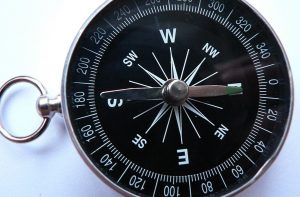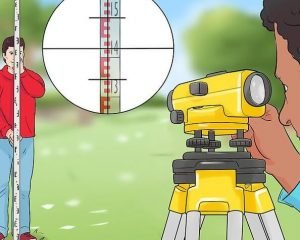Dumpy Level – Components, 3 Surveying Procedure & Benefits
The dumpy level is used to locate the points in the same horizontal plane and is a commonly used leveling instrument and also known as a builder’s level or automatic level.
The dumpy level instrument consists of a telescope tube firmly secured in two collars by the vertical spindle and fixed by adjusting screws to the stage.

The dumpy level is used to determine the elevations of different points and distance between the points of the same elevation and to its supports in the dumpy level the telescope is fixed hence in the vertical axis, it cannot be rotated and can only rotate in the horizontal axis.
Use of Dumpy Level in Surveying:
In surveying the dumpy level is mainly used for the following purposes such as;
- Among different locations of surveying land, to determine relative height and distance.
- Among different locations of surveying land, to determine relative distance.
Components of Dumpy Level:
There are the following components of dumpy level as given below;
- Telescope
- Bubble Tubes
- Compass
- Vertical Spindle
- Tribrach Screws
- Foot Screws
- Leveling Head
- Tripod.
Telescope:
To observe the distant object through the line of sight, the telescope is used and provided by its arrangement, and to the vertical spindle of the dumpy level, the telescope is fixed.
Parts of Telescope;
- Eye Piece
- Object Lens
- Diaphragm
- Focusing Screw
- Ray Shade.
Eye Piece:
To view the distant object, the eyepiece is used by the observer’s eye and contains magnifying glass which magnifies the observing image and accurate readings can be obtained.
Object Lens:
At the other end of the telescope objective lens are provided and this lens consists of two parts such as the back part consists of a concave lens and the front part consists convex type lens. The image obtained is always inverted from the objective lens.
Diaphragm:
In front of the eyepiece, the diaphragm is provided and it consists of crosshairs made of dark metal and arranged in perfect perpendicular positions.
Focusing Screw:
To adjust the focus of crosshairs and the image clarity focusing screw is used and by this focusing screw the magnification of eyepiece is managed.
Ray Shade:
To prevent the objective lens from sunlight or any other light rays which may cause disturbance to the line of sight, ray shade is used.

Bubble Tubes:
In the dumpy level, bubble tubes are provided for checking the instrument level and these tubes are arranged perpendicular to each other. On the top of the telescope two bubble tubes are provided, one tube is known as a cross bubble tube and the other is known as a longitudinal bubble tube and when both bubbles of the tubes are at the center of the tube than the instrument is in perfect position.
Compass:
To determine the magnetic bearing of line, the compass is used and the circular compass is provided just under the telescope in the case of the dumpy level. The compass contains a pointer in it and inside it, readings are marked. When pointer faces the north line from which the magnetic bearings are measured then the pointer is set to zero.

Vertical Spindle:
At the center of the whole instrument, the vertical spindle is located and in the horizontal direction, with respect to the vertical spindle, the telescope can be rotated. By using a vertical spindle, the instrument is connected to the tripod stand.
Tribrach & Foot screws:
To the leveling head or trivet, the tribrach plate is parallel and by leveling screws or foot screws it is connected to the trivet and the tribrach plate is adjusted by these.
To regulate the tribrach position foot screws are provided and the instrument can be leveled.
Leveling Head & Tripod:
Leveling head consists of two triangular-shaped plates and are arranged parallel and at the three corners of the plates in which foot screws are supported, three groves are provided.
To support the whole leveling instrument on its top, the tripod is used and it consists of three legs which help in adjusting in the required position. These legs may be solid or hollow and are of the same height.

The Procedure of Dumpy Level Surveying:
There are three steps in the procedure of dumpy level surveying as given below;
- Setting Up of Instrument.
- Leveling Up.
- Focusing.
Setting Up of Instrument:
By using clamp screws, the instrument is fixed to the tripod stand and spread the tripod legs and then at convenient height position the instrument. Fix the two legs in the ground at a point firstly and adjusting the third leg centering of the bubble in the bubble tubes is done.

Leveling Up:
By using foot screws or leveling screws the leveling up of an instrument is done and to any two leveling screws the telescope is arranged parallel. By turning both the screws either inwards or outwards, the bubble in the tube is centered and then the telescope is turned 90 degrees.
Until the bubble come to the center, the third screw is turned and repeats the process until the bubble in the tube always stays in the middle.
Focusing:
By adjusting eyepiece and focusing screw, focusing is done and until the crosshairs of the diaphragm are clearly visible eyepiece is adjusted. A white paper is used to obtain a sharp vision of crosshairs, to eliminate the parallax error.
To view the clear image of the objective or staff, focusing screw is adjusted and when the crosshairs bisect the objective or staff with clear vision then the focusing is said to be done.

Finally, take the levels of required positions and at different points at which the values are decided from a known benchmark point in that area, the levels are noted.
Benefits of Dumpy Level:
There are the following benefits of the dumpy level such as;
- The use of a dumpy level is easy.
- As per the requirement on any type of ground, adjustments can be made.
- In the case of the dumpy level, level readings are very accurate.
- For this level optical power is high.
- As compared to other instruments, the price of this instrument is cheap.
- It retains its two adjustments for a long time due to the rigidity.
Drawbacks of Dumpy Level Surveying:
There are the following drawbacks such as;
- To only horizontal angle measurement, it is limited.
- The angles are not accurately obtained by the dumpy level.
- In making accurate measurements, Civil Engineers may find it difficult.
